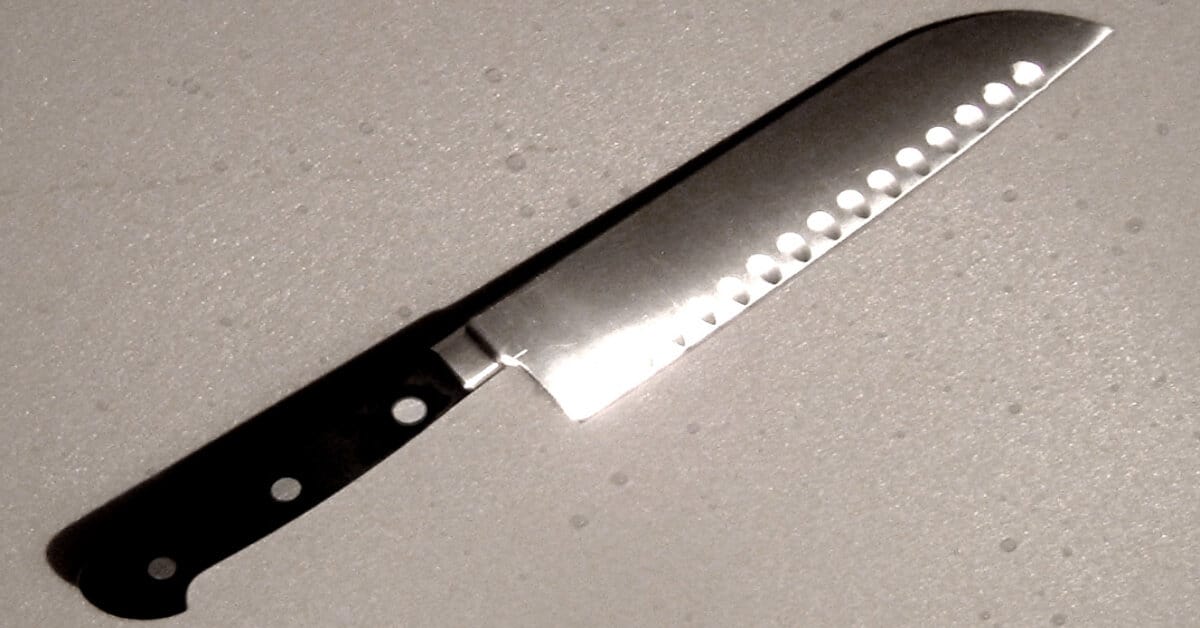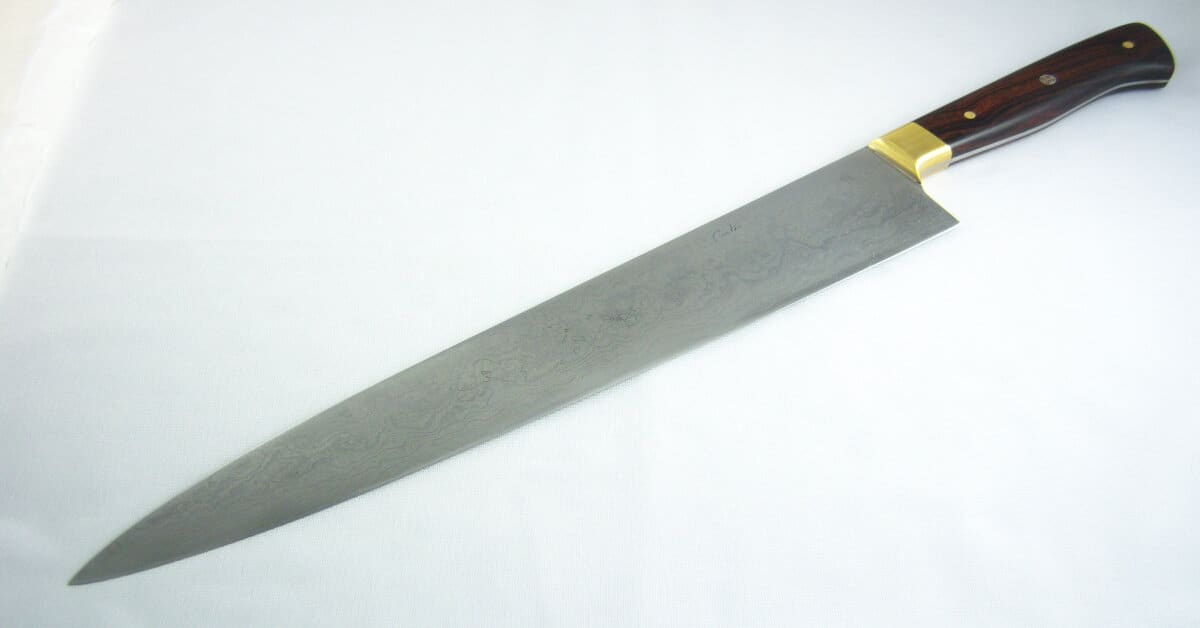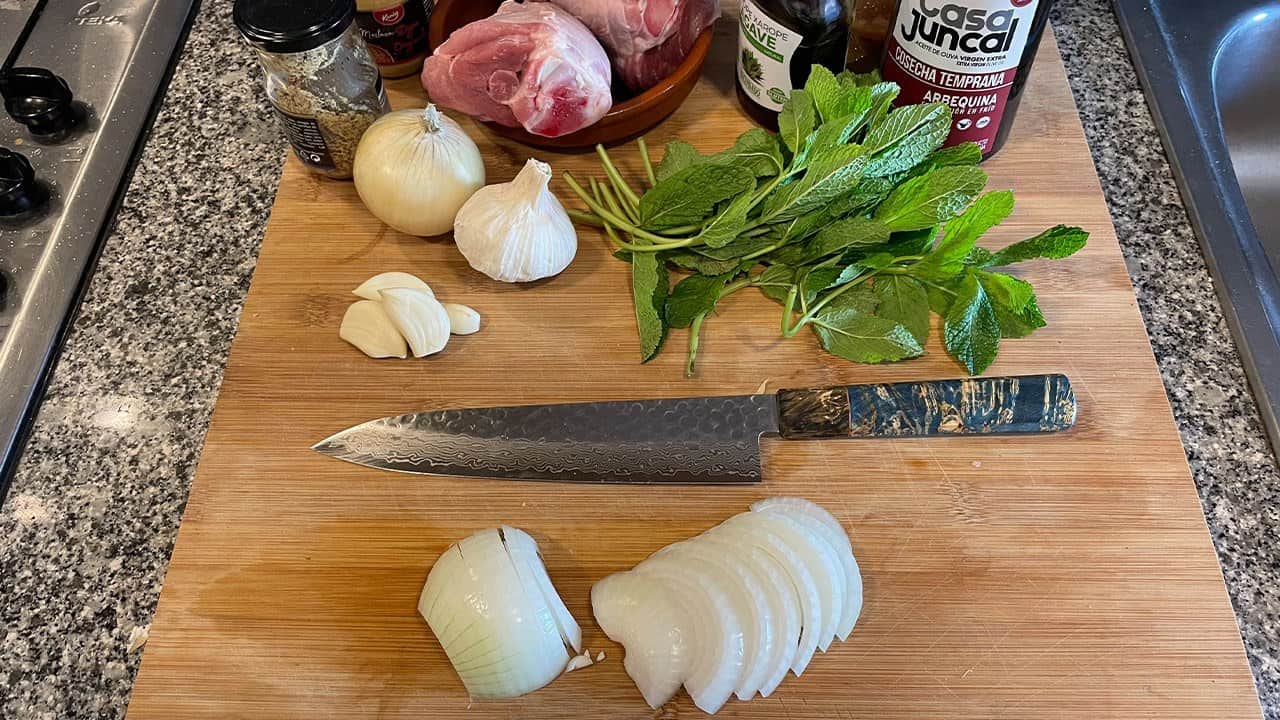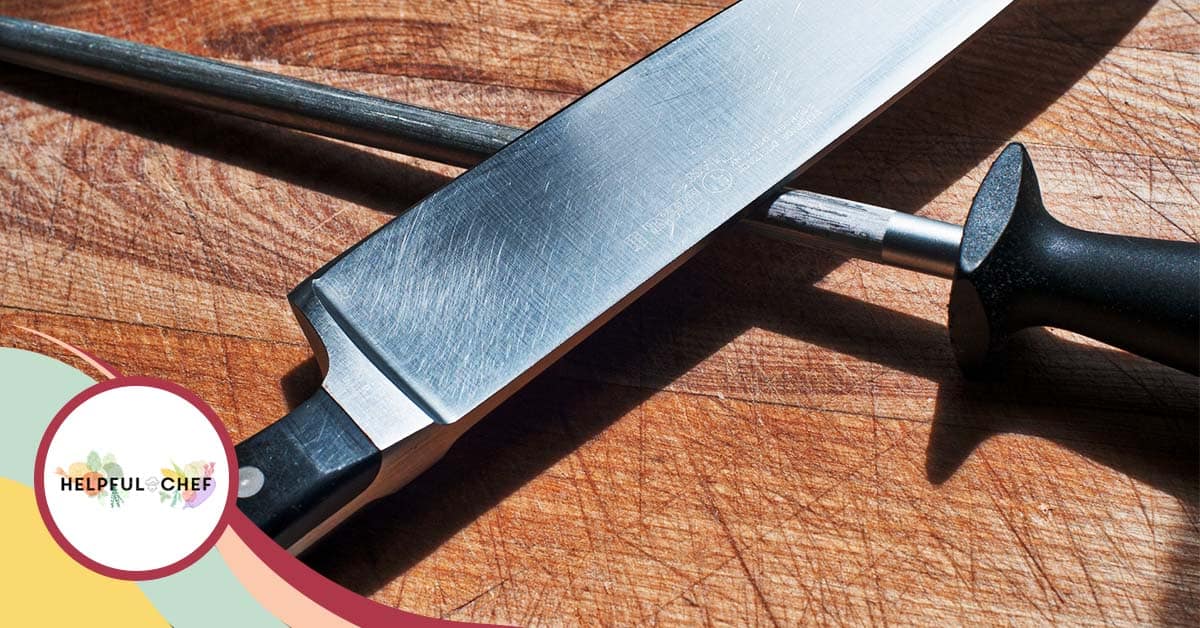The Best Nakiri Knives of 2022
When was the last time you were slicing up a pepper, only to find that the skin was still intact? Or struggled crushing a particularly fat clove of garlic under your chef’s knife? Or tipped chopped onions all over your stovetop trying to get them in the pan? These common kitchen problems can be solved by the addition of one kitchen knife to your arsenal: the nakiri knife. In this article, we take a closer look at nakiri knives and check out the top nakiri knives to buy in 2022.
Nakiri Knives – Everything You Need to Know
Before we look at our top choices for nakiri knives in 2022, let’s learn a little bit about nakiri knives, and the things you need to know to choose the right nakiri knife for you.

What is a Nakiri Knife?
‘Nakiri’ means ‘leaf cutter’ in Japanese, and a nakiri knife is a Japanese-style knife similar to a Western chef’s knife. However, looking at it, you’ll notice one key difference: the rectangular edge with a flat blade. If you’ve ever been caught out trying to slice up a pepper, only to find that the skin was still intact, you can blame the curved edge of your chef’s knife – the curve actually makes it much harder to cut through vegetable skins. The flat blade of the nakiri, on the other hand, makes a more complete contact with your chopping board, resulting in cleaner cuts.
Often likened to a Chinese cleaver, a nakiri blade is lighter and with a straighter blade. Compared to a similarly sized santoku knife or gyuto knife, a nakiri knife will tend to have a little more heft and perhaps a slight forward balance, due to the extra steel on the blade. This is what makes nakiri knives perfect for hard to chop veg like root vegetables, because the knife does plenty of the work for you.
A nakiri knife is an ideal choice for chopping the following:
- Cucumber
- Cabbages
- Carrots
- Garlic
- Mushrooms
- Onions and leeks
- Peppers
- Potatoes
- Tomatoes, if you don’t have a tomato knife
- Zucchini, butternut squash, and other summer squash
- Typical fruits such as apples, pears, oranges and lemons
- Hardier fruits like pineapple, melon or pomegranate
This list is by no means exhaustive – pretty much all fruits and veg are fine!
How to Use a Nakiri Knife
The joy of using a nakiri knife is that there is just one easy cutting method to master. It’s as simple as chopping up and down, and you can slide forwards or backwards as you move up and down if that’s easier for you. Christine Lau, executive chef at Kimika in New York City, demonstrates in the video below:
This motion is perfect for giving a bit more power when cutting harder veg, but is also great for more controlled, smaller cuts like mincing garlic. It might feel a little unnatural at first, particularly if you’re only used to rock-chopping, but once you get the hang of it, you’ll be able to tackle any veggies that come your way.
It’s important to make sure you stick to a wooden or plastic chopping board when using a nakiri knife, as a glass or stone board will blunt your blade much quicker, and increases the risk of chipping your blade. The trick is to motion up and down through your veg, not to bash your chopping board!
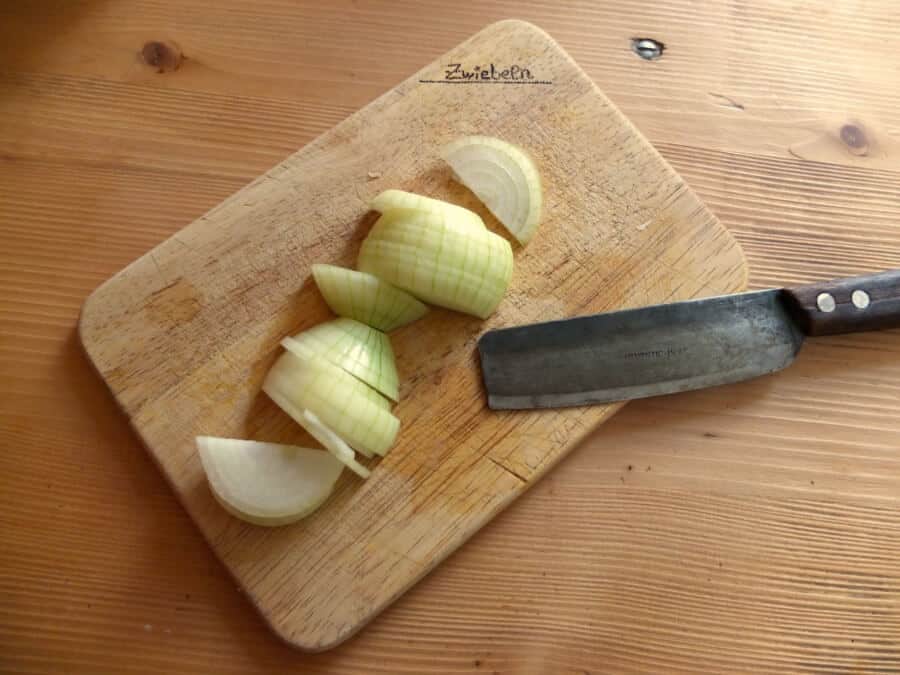
What to Look For When Buying a Nakiri Knife
If you’re looking to buy a nakiri knife, there are a number of factors to take into account to ensure you get a knife that suits you.
Blade
The blade of a nakiri knife can range from about 4.5- to 8.5 inches, but the most popular blades are in the 6.5- to 7-inch range. The length and width of the blade makes chopping hard veg easy. The best material for a nakiri knife is stainless steel, ideally with a high carbon content, as this will help to increase the blade’s hardness and edge retention so you won’t have to sharpen the knife as often.1 However, this increased hardness does make the blade more chip-prone, so try not to chop on hard surfaces, and only use the nakiri knife for vegetables, never bones or frozen food.
Unlike many Japanese knives like the usuba knife, the nakiri knife should be double-beveled. This means that the blade is ground at an angle on both sides, giving a balanced cut that can be used by left- and right-handers. Single bevel knives are great in some situations, however, if the nakiri knife you’re looking at isn’t double-beveled, we wouldn’t recommend it.2 For an overview of Japanese knives with single bevels, check out our guide to the best Japanese knives.
Size and Shape
The most important thing about a nakiri blade is its shape, specially chosen for chopping vegetables. Most nakiri knives do have a similar shape, but there are often subtle differences between different brands or collections.
A hollow or Granton edge will have indentations on the side of the blade. These help to reduce friction when chopping, and also work to prevent thinner slices of food sticking to your knife.3 A hammered tsuchime finish can have the same effect, with the addition of visual impact, much like Damascus steel. We recommend a nakiri knife with a hollow or hammered finish, but go for a regular straight edge if that suits you better.
A nakiri blade has no pointed end, meaning you can use the entire length of the blade’s edge, helping to increase your chopping efficiency. The rectangular blade of a nakiri knife is perfect for scooping up vegetables once you’ve chopped them, and the blade’s height helps to provide knuckle clearance, improving your comfort and giving you more space to chop larger bits of veg.
Weight
The nakiri knife is typically heavier than other Japanese knives, such as santoku or usuba knives. This extra heft can be useful when slicing more dense fruits and vegetables, like melons or squash. A nakiri knife that is too heavy will be ineffective for smaller, more delicate vegetables though. What you’re looking for is a balance between heft and maneuverability – a tool that you’d feel comfortable delicately mincing garlic with then moving straight onto breaking down a butternut squash!
Handle
The handle is another essential component of your knife, despite the fact that its often overlooked in favor of the sharpest or best-looking blade. We like to think of the handle as the bit of the knife you’ll get closest to, and it’s essential that it feels comfortable and safe in your hand when chopping, to avoid discomfort when cutting for longer periods and to prevent any more serious injuries.
There are two main types of handles: Japanese ‘wa’ handles, which can be octagonal, D-shaped or oval, and Western-style handles, which will more closely resemble the handle of a typical German-style knife. Whatever your preference, you’re looking for a handle that fits your hand size and allows you to get a good pinch grip on the blade. Other things to look out for are easy-to-clean materials that are durable and won’t harbor bacteria. Finally, the handle of a knife can be an aesthetic statement – take into account how your kitchen and other kitchen tools look, or go for something that will stand out!
Price
A final thing to consider is your personal budget. To some, spending upwards of $100 dollars on a knife that should only be used on vegetables might seem crazy. However, if veggies are a big part of your diet (and they should be!) it might be worth considering a specialized knife. Japanese knives are typically long-lasting if they’re treated with appropriate care, so there’s every chance your nakiri knife could be a lifetime investment.
The Best Nakiri Knives in 2022
Now that we’ve covered everything you need to know about nakiri knives, let’s take a look at our top picks for nakiri knives in 2022.
| Image | Product | Features | Price |
|---|---|---|---|
Best Overall  | Material: VG Max steel | Check Price | |
Best Budget Pick  | Material: Stainless steel | Check Price | |
Best Value for Money  | Material: High carbon stainless steel | Check Price | |
Best Hybrid Style  | Material: High carbon stainless steel | Check Price | |
Most Stylish  | Material: Alloy steel | Check Price |
‘Shun’ (pronounced ‘shoon’) is Japanese word which describes the exact moment that a vegetable is at its very best, a fruit is at its sweetest, or a piece of meat or fish is at its most flavorful.4 This concept is central to Japanese cuisine, and a philosophy that Shun Cutlery echo when crafting its kitchen equipment.
This 6.5-inch nakiri knife from Shun’s Classic range is handcrafted in the city of Seki in Gifu, Japan, famous for its 800-year history of bladesmiths crafting knives, swords and cutlery. 68 layers of stainless steel surround a VG-MAX cutting core, Shun’s exclusive steel formula, giving a beautiful Damascus pattern. Extra tungsten helps to craft a sharper edge, added chromium lends corrosion resistance, and additional cobalt and carbon give strength and durability to the cutting core, which is sharpened to a 16-degree angle on both sides.5 This results in a sharp blade with great cutting power. Of course, this extreme sharpness, alongside a Rockwell hardness of 61±1, comes at a cost – this blade is the most likely to chip or break of all the blades in this list.6
The ebony PakkaWood handle, a combination of hardwood veneers and waterproof resin, is waterproof, highly durable and won’t harbor nasty bacteria. In Japanese knifemaking tradition, the handle forms a D-shape that fits comfortably in your right hand. Shun claims that 60 percent of left-handers have no issue with the handle, but if you’re left-handed, you might want to reconsider.
Overall, this is a fantastic nakiri knife that stays true to the Japanese style. Shun also offers a registration system and lifetime free sharpening (provided you cover postage to Tualatin, Oregon), making this knife our top pick for the best nakiri knife.
Professional chef Christopher Kimball has dedicated his career to teaching cooking on TV, radio and award-winning cookbooks and magazines for over 30 years. His experience is central to the Christopher Kimball Edition range by Henckels, which features knives expertly designed for simple, effective everyday cooking.
This nakiri knife is designed to be the perfect choice for slicing, dicing and chopping fruits and vegetables. The sharp, slender, satin-finished blade is made from high-quality German stainless steel. It feels really light and holds a sharp edge well. The sides of the blade are wide and rectangular, making transporting food easy, but it would have been nice if they were hollowed as food can occasionally stick to the blade.
The fully-forged blade transitions seamlessly to the handle, and the blade is balanced perfectly here, helping with maneuverability. The polycarbonate plastic is triple-riveted for durability and feels great in the hand, ensuring fatigue-free chopping.
You might be interested in knowing that despite being constructed from German steel, this knife is actually manufactured in Spain – this is to drive down manufacturing costs, and Henckels appears to have passed these savings on to the consumer. This high quality but affordable nakiri knife takes our best budget pick award.
Manufactured in Germany, Zwilling’s Four Star series is their best-selling knife range worldwide. This collection of knives provides exceptional performance with comfortable ergonomics, and each knife is hand-finished and honed by artisan knifemakers.
The 6.5-inch blade, forged from a single piece of high-carbon stainless steel, is ice-hardened through Zwilling’s patented ‘friodur’ process, which results in a 55-58 HRC blade with an incredibly sharp 11-degree edge that stays sharper for longer, whilst remaining durable and resilient. Usually, it’s a trade-up between hardness and durability, but this ‘friodur’ process seems to really get the best of both.
The handle is made from polypropylene, and the generous bolster transitions seamlessly to the handle while giving finger protection and overall balance to the knife. A concealed full tang provides strength and further helps to balance the blade. The handle is ergonomic and really comfortable to hold, and the shape also prevents fatigue when chopping for longer periods of time.
Overall, this nakiri knife from Zwilling’s Four Star range seems to punch well above its price in terms of overall performance – it’s hard to pick an area that Zwilling seem to have compromised on. The high quality at a fair price helps this nakiri knife to secure our best value for money award.
Wüsthof is one of the most well-known German knife companies, which has been crafting traditional German-style knives in Solingen for centuries. Knives made in Solingen, known as the City of Blades, have been honored for their outstanding quality and craftsmanship for some 2,000 years.7 For this nakiri knife, Wüsthof have combined their German heritage with a Japanese influence, resulting in a fantastic hybrid-style knife perfect for chopping vegetables.
This starts with the 7-inch blade. Employing their Precision Edge Technology used on their more traditional German knives, Wüsthof have crafted a blade with an enhanced sharpness and exceptional edge retention, meaning that you won’t need to hone or sharpen your knife as much – useful for chopping through hard veggies like potatoes or squash. However, this nakiri knife is designed with a thinner blade than their traditional knives, and a hollow Granton edge is employed to help stop your vegetables sticking to the blade. A 10-degree double-beveled cutting edge is sharp, and the 58 HRC steel means it will hold an edge.
All knives in the Classic Ikon series feature a double bolster design. The balance of Japanese elegance and lightness and German heft here gives the nakiri knife a refined hybrid look and feel. The handle is made from polyoxymethylene, which is highly durable and resists fading or discoloration. It fits in the hand well and is comfortable to use, and feels secure even when your hands are wet from washing vegetables.
Wüsthof cutlery is corrosion- and dulling-resistant – you can guarantee a greater working life for your knife by sticking to wooden or plastic chopping boards and handwashing after use, as recommended by Wüsthof. Treat your blade with care and Wüsthof will stay true to their limited lifetime warranty.
Another entry from Japanese brand Shun, this time from their Premier series, the first thing you’re likely to notice about this nakiri knife is the beautiful tsuchime (tsoo-CHEE-may) finish. The striking liquid effect is achieved by hammering the layered Damascus steel, then applying a mirror blade polish for extra shine. Shun describes this look as ‘at once rustic and sophisticated’, and we couldn’t agree more.
However, the real beauty is in this blade’s performance. The 5.5-inch blade has a high-carbon VG-Max core, sharpened to a 16-degree double bevel. This cutting core has a Rockwell hardness of 60-61, meaning that it will retain its edge for a long time. However, it’s also more likely to chip, so be extra careful when storing your knife, and never chop on hard surfaces like glass or stone chopping boards. That striking tsuchime finish also provides air pockets between the blade and your food, which helps to stop the food sticking to the blade.
The handle is made from a walnut Pakkawood, and the symmetrical palm swell nestles into the hand to provide confident control for both hands of all sizes – and it’s perfect for lefties too! The composite full tang construction provides strength whilst the embossed endcap and brass ring provide both balance and beauty.
Overall, this knife is a fantastic choice if you’re looking for a nakiri knife and want to make a visual impact in your kitchen. Again, Shun offers its registration system and lifetime free sharpening if you cover shipping costs. The high quality and magnificent look of this nakiri knife make it our most stylish pick.
The Final Verdict
That covers our top choices for nakiri knives. We’ve looked at a range of blades that should suit all kinds of needs, budgets and use cases, but our top choice overall is the Shun Classic 6.5-inch nakiri knife. Shun’s construction remains true to the Japanese knifemaking tradition, and the blade is hard, sharp and highly effective at chopping a wide range of fruit and veggies. The quality construction will last for years if treated with care, and Shun also offers a free sharpening service and limited lifetime warranty, providing extended care and giving you peace of mind.
One thing to note is that we found no real difference between this Premier Shun knife and the Classic series with regards to how they hold an edge, how likely they are to chip, and ease of sharpening, so if you don’t mind splashing out the extra cash for a more stylish blade, know that you’re not making any compromises with quality other than the shorter blade length.
FAQs
Q: Why do I need a knife just for vegetables?
A: The short answer is, you don’t. A multi-purpose kitchen knife like a chef’s knife or a santoku knife will be absolutely fine for any vegetable chopping you need to do. However, if you find yourself cooking with a lot of veggies (which you should be!) it can be really useful to have a specialized tool that you know you can use to chop vegetables quickly and effectively.
Q: Can I use a nakiri knife for cutting meat?
A: The nakiri knife is specially designed for chopping vegetables, so it’s not ideal for cutting meat really. You probably won’t have any trouble slicing through chicken breasts or filleted fish, but it’s not the best knife for the job. Despite its cleaver-like shape, you should not use a nakiri knife for chopping bones under any circumstances – you’d be pretty likely to chip or damage the blade. For more on different knives and their duties, check out our kitchen knife guide.
Q: Can I use a nakiri knife for sushi?
A: The nakiri knife is perfect for slicing vegetables delicately, but if you’re looking to make sushi from scratch, there are a couple more knives that should be on your radar – we’d start off with a yanagiba knife and take it from there. For more information, check out our guide to the best sushi knives.
References
1 Matt Davidson (15 December 2021), ‘Knife Steel Composition Chart’. Accessed at: https://knifeinformer.com/knife-steel-composition-chart/.
2 Hasu Seizo (26 June 2020), ‘Single Bevel Knives vs Double Bevel Knives’. Accessed at: https://hasuseizo.com/blogs/japanese-kitchen-knives/single-bevel-knives-vs-double-bevel-knives.
3 HDMD (16 December 2021), ‘What is Granton Edge?’. Accessed at: https://blog.hdmdknives.com/granton-edge.html.
4 Shun (n.d.), ‘At the Peak of Perfection’. Accessed at: https://shun.kaiusa.com/what-does-shun-mean.
5 Matt Davidson (15 December 2021), ‘Knife Steel Composition Chart’. Accessed at: https://knifeinformer.com/knife-steel-composition-chart/.
6 York Saw & Knife (n.d.), ‘Guide to Rockwell Hardness’. Accessed at: https://www.yorksaw.com/rockwell-hardness/.
7 Messervertrieb Rottner (n.d.), ‘History of the City of Blades, Solingen’. Accessed at: https://messervertrieb-rottner.de/en/wissenswertes/geschichte-der-klingenstadt-solingen/.
